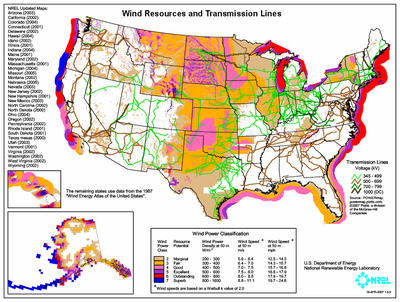Wind
Resources

(click image to enlarge)
Wind is location dependent. A wind power farm must be located where the wind blows. Although there are sufficient locations in the USA where optimal conditions exist for wind power to make a substantial contribution to the national electrical power supply, these locations are usually distant from population centers where power is most in demand and, thus, remote from the electrical grids that furnish power to those populations.
Wind Turbines
Wind can be harnessed using wind turbines to produce electricity. Wind turbine technology is advanced, and under appropriate conditions can be used to provide substantial power to an electrical grid or to furnish a remote, off-grid location with a significant portion of its power requirements.
Variability
Wind is a variable energy source. It blows in accordance with weather conditions, height, and location. The wind blows more at levels high above the ground than it does at the surface. Some areas are more windy than others. Harnessing the wind for the generation of power depends on the construction of wind turbines that are tall enough and located in optimally windy locations.
National energy independence will be served by the use of wind to produce electricity. The hope is that if the variability problems of wind power can be solved, the cost of electricity from wind sources will be much less in the future than the cost from other sources of non-renewable energy.
Environment
There are negative issues relating to wind turbines and their effect on the environment.
- Opponents point out the danger to birds and bats, which can be killed or injured by the rotating turbine blades.
- There are those who feel that there are distracting, distressing noise levels associated with the turbine operation.
- The aesthetics of wind turbine farms meets with mixed reviews, accepted and enjoyed by some, deeply opposed by others.
The negative environmental effects of wind power generation, however, must also be considered in the light of positive effects, such as greatly diminished pollution of the air and zero carbon emissions.
Economics
There are several important variables in considering the cost of a wind power installation. There is a large capital cost in the construction of a wind farm. This is not only reflected in the cost of the turbines themselves, but also includes the cost of extending the complex of electrical grid cables and substations to the wind farm location. Since the windy areas that are optimal for the generation of wind-based electrical power tend to be in remote areas, far from the main body of the national grid, the cost of extending those grid facilities can be very high.
Ongoing power production after construction is complete is considerably more favorable than the initial construction costs. The cost of "fuel" is zero, so the cost of daily generation of power is dependent mostly on other factors, such as the need for additional power sources, environmental effects, and maintenance of the wind turbines. These costs, however, tend to be considerably less, overall, than the upfront capital requirements.
Difficulties
Two difficulties with wind power have yet to be solved. First, there's the storage problem. The wind blows intermittently, even in the best of locations. But base energy is needed constantly and consistently. If wind is to become a truly viable power supplier, a low-cost, large-scale method will have to be devised to store that energy for use as needed by the grid.
Second, the U.S. national electrical grid is not extensive in areas that provide the strongest, most consistent wind conditions. To take advantage of wind power, the grid will have to be expanded and extended into these regions with many miles of costly, intrusive high voltage transmission lines.